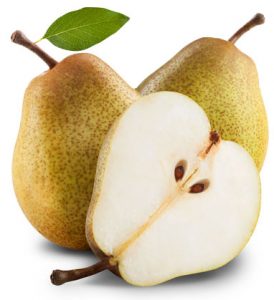Print Recipe Ingredients: 2 diced bartlett pears 1/2 cup brown sugar 1tsp cinnamon ⅛ tsp nutmeg 2 eggs 2 cups All Purpose Flour ½ tsp salt 2 tsp vanilla extract […]
Lyman Orchards Pick Your Own Pear Orchards are not open yet for the 2024 season. Please be sure to call our Pick-Your-Own Hotline at 860-349-6015 for the latest picking conditions and updates, or check out our Facebook page for daily updates.
Our Pick Your Own Pear trees are nestled on 200 acres of Pick Your Own fruit orchards and fields overlooking the scenic Connecticut River Valley. We have one of the largest pear orchards in Connecticut. It's no wonder why Lyman Orchards was voted Connecticut's Best Pick Your Own Farm!
Pears are one of the world's oldest cultivated and most beloved fruits. In The Odyssey, the Greek poet laureate Homer lauds pears as a "gift of the gods”. Early colonists brought the first pear trees to America's eastern settlements. Pears rank second to the apple as the most popular fruit. They can be eaten and used in the same way as the apple. Softer in texture than the apple, its unique shape reflects its luscious nature.
If you're looking for a fun way to spend a day in Connecticut, a visit to Lyman Orchards PYO Pear Orchards is the perfect destination for a wholesome, fun, family-friendly getaway! And because we grow so many varieties of fruits, it's worth the trip! The Pear season lasts for 6 weeks (mid August-late September) and traditionally overlaps the Peach season (mid July-Late September) and the Apple Season (mid August - mid November).
For the best PYO pears experience, be sure to check our Facebook Page for daily updates, and read our pick your own tips
$14 for a ½ peck bag
$25 for a peck bag
$45 for a ½ bushel bag
Lyman Orchards has 900 pear trees spread over 8.5 acres. We grow multiple varieties of pears. Some of our early season pears include Clapp's Favorite, Green Bartlett, and Red Bartlett. Other varieties include Bosc and Magness. We also grow specialty Asian Pears for picking including 20th Century, Shinseiki, Hosui, and Niitaka.
Pear picking is a great family friendly activity!
Below are some of the health benefits pears provide.
There are so many tasty ways to include these nutritious fruits into your breakfast, lunch, dinner or dessert!
Spend a morning or afternoon pear picking at Connecticut’s Sweet Spot®, Lyman Orchards in Middlefield, CT
While pear picking season is generally considered to be in the fall, each variety essentially has its own little “mini-season.” So keep checking the Pick Your Own hotline 860-349-6015 for updated “what’s picking” news and don’t miss out on trying each variety – you may just discover some new favorites!

Print Recipe Ingredients: 2 diced bartlett pears 1/2 cup brown sugar 1tsp cinnamon ⅛ tsp nutmeg 2 eggs 2 cups All Purpose Flour ½ tsp salt 2 tsp vanilla extract […]
Print Recipe Ingredients: 4 bosc Pears (core out the center) 1 cup Blue cheese (crumbled) 1 cup sliced almonds ¼ cup fine chopped vidalia onion 3 garlic cloves minced 1 […]
32 Reeds Gap Rd
Middlefield, CT 06455
Phone: 860-349-6000
700 Main Street
Middlefield, CT 06455
Phone: 860-349-6031
70 Lyman Road
Middlefield, CT 06455
Phone: 860-349-6033
105 South Street
Middlefield, CT 06455
Phone: 860-349-6015